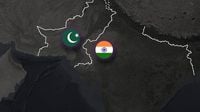In a bold and unprecedented move, India launched a coordinated precision strike operation on May 7, 2025, targeting nine identified terror hubs in Pakistan and Pakistan-occupied Jammu & Kashmir (PoJK). Codenamed Operation Sindoor, the mission marks a significant escalation in India's ongoing efforts to dismantle the infrastructure supporting cross-border terrorism. The operation was executed with remarkable precision by the Indian Army, Navy, and Air Force, employing advanced special munitions to neutralize key terror sites long protected by Pakistan's military and Inter-Services Intelligence (ISI).
Prime Minister Narendra Modi personally monitored the operation throughout the night, a clear indication of the high stakes involved. According to reports from ANI, all nine targets were destroyed in the assault, which were integral to the operations of notorious anti-India groups such as Jaish-e-Mohammad (JeM), Lashkar-e-Taiba (LeT), and Hizbul Mujahideen (HM).
The Markaz Subhan Allah in Bahawalpur, operational since 2015, served as the central headquarters of JeM. This facility is linked to several significant terror operations against India, including the infamous Pulwama attack of February 2019. It is home to key figures such as JeM Chief Maulana Masood Azhar and the de-facto Chief Mufti Abdul Rauf Asghar, who are known for their roles in orchestrating attacks against Indian targets.
Another critical site targeted was the Markaz Taiba in Muridke, established in 2000 and recognized as the premier training ground for LeT. This facility, located in Sheikhupura, Punjab, processes over 1,000 recruits annually and has historical ties to international terror operatives. Notably, it was financed in part by Osama bin Laden and has previously hosted individuals involved in the 26/11 Mumbai attacks.
The operation also focused on the Sarjal/Tehra Kalan facility in Narowal, a JeM stronghold cleverly hidden within a government-run Primary Health Centre. Located just 6 km from the international border in the Samba sector of Jammu, this site has been a key launchpad for cross-border infiltration, used for digging tunnels and launching drones to transport arms and narcotics into India.
In Sialkot, the Mehmoona Joya facility, operating under Hizbul Mujahideen, is located within the Bhutta Kotli government facility and plays a crucial role in pushing HM cadres into the Jammu region, providing them with weapons training and operational guidance.
In PoJK, the Markaz Ahle Hadith Barnala near Barnala town serves as a significant base for Lashkar, accommodating 100 to 150 terrorists and supporting infiltration into sectors like Poonch, Rajouri, and Reasi. Additionally, Markaz Abbas in Kotli, linked to JeM, hosts 100 to 125 cadres involved in planning attacks in the Rajouri-Poonch sectors.
The Maskar Raheel Shahid facility in Kotli, one of Hizbul Mujahideen's oldest training sites, caters to around 150 to 200 terrorists, focusing on specialized training in tactics such as sniping and survival in mountainous terrain. Another major training site, the Shawai Nallah Camp in Muzaffarabad, also known as Bait-ul-Mujahideen, has been pivotal in LeT’s operational history, training up to 250 cadres before they are deployed to forward launching sites.
Finally, the Markaz Syedna Bilal, located opposite the Red Fort in Muzaffarabad, functions as the primary JeM transit hub in PoJK, hosting 50 to 100 terrorists at any given time. Training at this center is reportedly enhanced by Pakistan’s Special Services Group (SSG), solidifying its role in active infiltration planning and execution.
As the dust settled from Operation Sindoor, the geopolitical landscape between India and Pakistan grew increasingly tense. Reports indicated that Pakistan and India were trading artillery fire and threats of retaliation following the Indian strikes. India claimed responsibility for launching missiles targeting "terrorist infrastructure" in Pakistan and Pakistan-administered Kashmir, while Pakistani officials denied that any of the six locations targeted were militant camps.
Pakistan's military asserted that it shot down five Indian aircraft during the attack, a claim that remains unverified by India. The situation escalated following a deadly attack in Pahalgam on April 22, which resulted in the deaths of 26 tourists, predominantly Hindu men. India has blamed Pakistan for this attack, further inflaming tensions.
Amidst the ongoing conflict, digital connectivity has also been affected, with reports emerging that Google Maps is no longer displaying routes between India and Pakistan. Despite Lahore being less than 50 km from Amritsar, users have noted the absence of directions or connectivity on the platform. This disruption coincides with missile strikes, drone attacks, and heavy cross-border firing, as major cities like Islamabad, Peshawar, and Muzaffarabad find themselves under siege.
As both nations brace for potential further military action, the international community watches closely. Pakistan has vowed retaliation, stating it will respond at a time and place of its choosing, while India has promised retribution for any further provocations. The night following the Indian strikes saw additional volleys exchanged, with Pakistan claiming to have downed 25 Indian drones in its airspace, a claim that India countered by stating it had "neutralized" Pakistan's efforts to strike its military sites.
The situation remains fluid, with both sides preparing for what could become a prolonged and escalating conflict. As tensions rise, the impact on civilians and the broader regional stability hangs in the balance, leaving many to wonder what the future holds for this volatile relationship.


